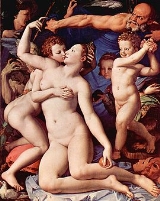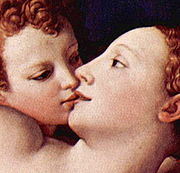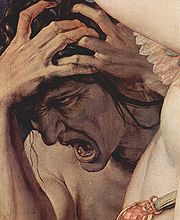
Venus, Cupid, Folly and Time
Encyclopedia
Venus, Cupid, Folly, and Time (also called An Allegory of Venus and Cupid and A Triumph of Venus) is an allegorical
painting by the Florentine
artist Agnolo Bronzino. It is now in the National Gallery
, London.
About 1546, Bronzino was commissioned to create a painting that has come to be known as Venus
, Cupid
, Folly
, and Time. It displays the ambivalence, eroticism, and obscure imagery that are characteristic of the Mannerist
period, and of Bronzino's master Pontormo
.
The painting may have been commissioned by Cosimo I de' Medici, Grand Duke of Tuscany
or by Francesco Salviati, to be presented by him as a gift to Francis I of France
. Vasari wrote that it was sent to King Francis, though he does not specify by whom. The erotic imagery would have appealed to the tastes prevalent in both the Medici
and French courts at this time. The attention to texture
and wealth is also consistent with Bronzino's aristocrat
ic patronage. The painting was brought by Napoleon from Paris
to Vienna
, where it was owned by Johann Keglević
since 1813. Since 1860 it has been in London. The figure of Venus can be likened to a precious object (such as a marble statue) in a luxurious setting, desirable because of her unavailability.
Crowded into the claustrophobic foreground of the painting are several figures whose identities have been the subject of extensive scholarly debate. The themes of the painting appear to be lust
, deceit, and jealousy. At times it has also been called A Triumph of Venus. Its meaning, however, remains elusive. Cupid, along with his mother (Venus) and the nude putto
, to the right, are all posed in a typical Mannerist figura serpentinata
form.
 The two central figures are easily identified by their attributes as Venus and Cupid. For example, she holds the golden apple she won in the Judgement of Paris
The two central figures are easily identified by their attributes as Venus and Cupid. For example, she holds the golden apple she won in the Judgement of Paris
, while he sports the characteristic wings and quiver
. Both figures are nude, illuminated in a radiant white light. Cupid fondles his mother's bare breast and kisses her lips.
 The bearded, bald figure to the upper right of the scene is believed to be Time, in view of the hourglass behind him. He sweeps his arm forcefully out to his right. Again, it is difficult to interpret his gesture with any certainty; it could be to prevent the figure at the far left of the picture from shielding the incestuous transgressions of Venus and the adolescent Cupid with the billowing blue fabric that provides a screen between the figures in the fore and background. Many believe that his gesture seems to say "Time is fleeting, and you never know when it may be all over." The figure opposite Time, and also grasping at the drapery, is usually called Oblivion
The bearded, bald figure to the upper right of the scene is believed to be Time, in view of the hourglass behind him. He sweeps his arm forcefully out to his right. Again, it is difficult to interpret his gesture with any certainty; it could be to prevent the figure at the far left of the picture from shielding the incestuous transgressions of Venus and the adolescent Cupid with the billowing blue fabric that provides a screen between the figures in the fore and background. Many believe that his gesture seems to say "Time is fleeting, and you never know when it may be all over." The figure opposite Time, and also grasping at the drapery, is usually called Oblivion
because of the lack of substance to his form—eyeless sockets and mask-like head. The mask-like face of this figure is echoed by the image of two actual masks in the lower right-hand corner.
The identity of the remaining figures is even more ambiguous. The old woman rending her hair (see detail at right) has been called Jealousy
—though some believe her to represent the ravaging effects of syphilis
(result of unwise intercourse). The creature at the right-hand side behind Folly, with a girl's face and grotesque body, extending a honeycomb
with her left hand attached to her right arm, may represent Pleasure and Fraud
. There is, however, no consensus on these identifications.
Allegory
Allegory is a demonstrative form of representation explaining meaning other than the words that are spoken. Allegory communicates its message by means of symbolic figures, actions or symbolic representation...
painting by the Florentine
Florence
Florence is the capital city of the Italian region of Tuscany and of the province of Florence. It is the most populous city in Tuscany, with approximately 370,000 inhabitants, expanding to over 1.5 million in the metropolitan area....
artist Agnolo Bronzino. It is now in the National Gallery
National Gallery, London
The National Gallery is an art museum on Trafalgar Square, London, United Kingdom. Founded in 1824, it houses a collection of over 2,300 paintings dating from the mid-13th century to 1900. The gallery is an exempt charity, and a non-departmental public body of the Department for Culture, Media...
, London.
About 1546, Bronzino was commissioned to create a painting that has come to be known as Venus
Venus (mythology)
Venus is a Roman goddess principally associated with love, beauty, sex,sexual seduction and fertility, who played a key role in many Roman religious festivals and myths...
, Cupid
Cupid
In Roman mythology, Cupid is the god of desire, affection and erotic love. He is the son of the goddess Venus and the god Mars. His Greek counterpart is Eros...
, Folly
Folly (allegory)
Folly was a common allegorical figure in medieval morality plays and in allegorical artwork through the Renaissance. The depiction is generally of a young man, often similar in appearance to a jester or the tarot card, The Fool...
, and Time. It displays the ambivalence, eroticism, and obscure imagery that are characteristic of the Mannerist
Mannerism
Mannerism is a period of European art that emerged from the later years of the Italian High Renaissance around 1520. It lasted until about 1580 in Italy, when a more Baroque style began to replace it, but Northern Mannerism continued into the early 17th century throughout much of Europe...
period, and of Bronzino's master Pontormo
Pontormo
Jacopo Carucci , usually known as Jacopo da Pontormo, Jacopo Pontormo or simply Pontormo, was an Italian Mannerist painter and portraitist from the Florentine school. His work represents a profound stylistic shift from the calm perspectival regularity that characterized the art of the Florentine...
.
The painting may have been commissioned by Cosimo I de' Medici, Grand Duke of Tuscany
Cosimo I de' Medici, Grand Duke of Tuscany
Cosimo I de' Medici was Duke of Florence from 1537 to 1574, reigning as the first Grand Duke of Tuscany from 1569.-Biography:...
or by Francesco Salviati, to be presented by him as a gift to Francis I of France
Francis I of France
Francis I was King of France from 1515 until his death. During his reign, huge cultural changes took place in France and he has been called France's original Renaissance monarch...
. Vasari wrote that it was sent to King Francis, though he does not specify by whom. The erotic imagery would have appealed to the tastes prevalent in both the Medici
Medici
The House of Medici or Famiglia de' Medici was a political dynasty, banking family and later royal house that first began to gather prominence under Cosimo de' Medici in the Republic of Florence during the late 14th century. The family originated in the Mugello region of the Tuscan countryside,...
and French courts at this time. The attention to texture
Texture (painting)
Texture in painting is the look and feel of the canvas. It is based on the paint, and its application, or the addition of materials such as ribbon, metal, wood, lace, leather and sand. The concept of 'painterliness' also has bearing on texture. The texture stimulates two different senses; sight...
and wealth is also consistent with Bronzino's aristocrat
Aristocracy
Aristocracy , is a form of government in which a few elite citizens rule. The term derives from the Greek aristokratia, meaning "rule of the best". In origin in Ancient Greece, it was conceived of as rule by the best qualified citizens, and contrasted with monarchy...
ic patronage. The painting was brought by Napoleon from Paris
Paris
Paris is the capital and largest city in France, situated on the river Seine, in northern France, at the heart of the Île-de-France region...
to Vienna
Vienna
Vienna is the capital and largest city of the Republic of Austria and one of the nine states of Austria. Vienna is Austria's primary city, with a population of about 1.723 million , and is by far the largest city in Austria, as well as its cultural, economic, and political centre...
, where it was owned by Johann Keglević
House of Keglević
The House of Keglević is a Croatian noble family originally from Dalmatia, their members were pointed out in public life, also as soldiers...
since 1813. Since 1860 it has been in London. The figure of Venus can be likened to a precious object (such as a marble statue) in a luxurious setting, desirable because of her unavailability.
Crowded into the claustrophobic foreground of the painting are several figures whose identities have been the subject of extensive scholarly debate. The themes of the painting appear to be lust
Lust
Lust is an emotional force that is directly associated with the thinking or fantasizing about one's desire, usually in a sexual way.-Etymology:The word lust is phonetically similar to the ancient Roman lustrum, which literally meant "purification"...
, deceit, and jealousy. At times it has also been called A Triumph of Venus. Its meaning, however, remains elusive. Cupid, along with his mother (Venus) and the nude putto
Putto
A putto is a figure of an infant often depicted as a young male. Putti are defined as chubby, winged or wingless, male child figure in nude. Putti are distinct from cherubim, but some English-speakers confuse them with each other, except that in the plural, "the Cherubim" refers to the biblical...
, to the right, are all posed in a typical Mannerist figura serpentinata
Figura serpentinata
Figura Serpentinata is a style in painting and sculpture that is typical of Mannerism. It is similar, but not identical, to contrapposto, and features figures often in a spiral pose...
form.

Judgement of Paris
thumb |right |460px |[[The Judgment of Paris |The Judgment of Paris]], [[Peter Paul Rubens]], ca 1636...
, while he sports the characteristic wings and quiver
Quiver
A quiver is a container for arrows. Quivers have been traditionally made of leather, bark, wood, furs and other natural materials; modern quivers are often made of metal and plastic....
. Both figures are nude, illuminated in a radiant white light. Cupid fondles his mother's bare breast and kisses her lips.

Oblivion
Oblivion may refer to:*The Elder Scrolls IV: Oblivion, a 2006 video game*Oblivion , a Marvel Comics character*Oblivion , a 1994 western/science fiction film from Full Moon Entertainment...
because of the lack of substance to his form—eyeless sockets and mask-like head. The mask-like face of this figure is echoed by the image of two actual masks in the lower right-hand corner.
The identity of the remaining figures is even more ambiguous. The old woman rending her hair (see detail at right) has been called Jealousy
Jealousy
Jealousy is a second emotion and typically refers to the negative thoughts and feelings of insecurity, fear, and anxiety over an anticipated loss of something that the person values, particularly in reference to a human connection. Jealousy often consists of a combination of presenting emotions...
—though some believe her to represent the ravaging effects of syphilis
Syphilis
Syphilis is a sexually transmitted infection caused by the spirochete bacterium Treponema pallidum subspecies pallidum. The primary route of transmission is through sexual contact; however, it may also be transmitted from mother to fetus during pregnancy or at birth, resulting in congenital syphilis...
(result of unwise intercourse). The creature at the right-hand side behind Folly, with a girl's face and grotesque body, extending a honeycomb
Honeycomb
A honeycomb is a mass of hexagonal waxcells built by honey bees in their nests to contain their larvae and stores of honey and pollen.Beekeepers may remove the entire honeycomb to harvest honey...
with her left hand attached to her right arm, may represent Pleasure and Fraud
Fraud
In criminal law, a fraud is an intentional deception made for personal gain or to damage another individual; the related adjective is fraudulent. The specific legal definition varies by legal jurisdiction. Fraud is a crime, and also a civil law violation...
. There is, however, no consensus on these identifications.
In popular culture
- The foot at the lower left hand corner is the original source of the emblematic Monty PythonMonty PythonMonty Python was a British surreal comedy group who created their influential Monty Python's Flying Circus, a British television comedy sketch show that first aired on the BBC on 5 October 1969. Forty-five episodes were made over four series...
foot. - In the manga From Eroica With LoveFrom Eroica with Loveis a long-running shōjo manga by Yasuko Aoike which originally began publication in 1976 by Akita Shoten. The series ran irregularly in the Japanese anthology magazine Viva Princess from December 1976 to April 1979, then moved to the sister publication Princess beginning in September 1979...
this work was stolen by the title character, the art thief Dorian Red, Earl of Gloria. - A portion of the image (Venus and Cupid) is used for the cover of the CD single "Principles of LustPrinciples of Lust"Principles of Lust" is a 1991 song created by the musical project, Enigma. The single was the third one released from their debut album, MCMXC a.D. Confusingly, the single version of "Principles of Lust" is actually "Find Love", part two of the album version of "Principles of Lust", which includes...
", by EnigmaEnigma (musical project)Enigma is an electronic musical project founded in Germany by Michael Cretu, David Fairstein and Frank Peterson in 1990. The Romanian-born Cretu conceived the Enigma project while working in Germany, but has based his recording studio A.R.T. Studios in Ibiza, Spain, since the early 1990s until May...
. - The painting is much discussed by characters in the novel What's Bred in the BoneWhat's Bred in the BoneWhat's Bred in the Bone is the second novel in the Canadian writer Robertson Davies' Cornish Trilogy. It is the life story of Francis or Frank Cornish, whose death and will were the starting point for the first novel, The Rebel Angels....
, by Robertson DaviesRobertson DaviesWilliam Robertson Davies, CC, OOnt, FRSC, FRSL was a Canadian novelist, playwright, critic, journalist, and professor. He was one of Canada's best-known and most popular authors, and one of its most distinguished "men of letters", a term Davies is variously said to have gladly accepted for himself...
.

